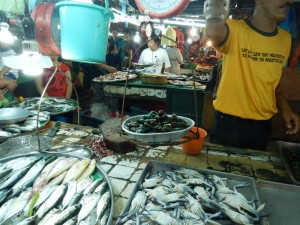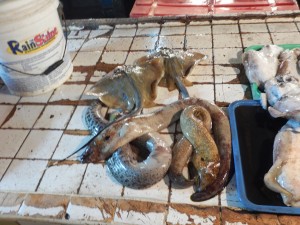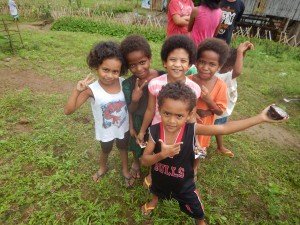There is so much to catch up on since I arrived in Morong. I am living in Poblacion, a rural barangay despite being the municipal center of Morong province. The other coastal resource volunteers live in Sabang and Mabayo, we are all within a 30 minute car ride from each other. Every week is filled with class, we have Tagalog in the morning from 8am-12pm. Then we go home for lunch. After lunch, we usually travel to Mabayo for our technical sessions. Technical training is either lecture based or active field work. In the field, we have conducted Mangrove and Seagrass assessments. We have been waiting to do our coral survey, because it is the rainy season we have to wait for the weather to accommodate us.
I have a wonderful host family. My host parents are Ate Jasmine and Kuya Jun. They have three daughters. Jamie, the youngest, is 14 and still lives at home. She was shy at first, but has really warmed up. We watch movies and study together. The two older girls live in Baguio City and Manila.
When we arrived here three weeks ago, we disembarked our bus at the covered court, an open air basketball court with a roof across the street from the Municipal Hall. Our host families were waiting to meet us. We learned who our host families were by matching up two pieces of paper cut like puzzle pieces. Ate Jasmine and I went home on a tryke, a motorcycle with a side car that is a common mode of transportation in the Philippines. We put all my luggage in and on the tryke and took a brief ride home.
My house is very nice. I have my own room with a fan. We have a kitchen with a stove, oven, and refrigerator. We have a separate CR (toilet) and washroom with a shower, though I prefer to use the bucket and tabo to bathe. Kuya Jun raises roosters for cock fights, and they also have some caged birds and a dog.
Much of the grocery shopping here is done in open air markets. There are grocery stores and sari-sari stores (small variety stores) too, but most of the fresh items are purchased at the marketplace. There are a variety of fruits and vegetables available, including: multiple varieties of banana, pineapple, jackfruit, durian, rambutan, coconut, eggplant, bitter melon, soursop, yard long beans, kangkong (swamp spinach), and other locally available options. The seafood at the market in Morong offers a limited selection of mostly local fish and lots of Tilapia and Bangus (milkfish) which are farm raised. We traveled to Olongapo City on Subic Bay and visited the fish market there. The variety of seafood was impressive. They had the standard farm raised options as well as moray eel, pancit (squid), parrot fish, trigger fish, juvenile lapu-lapu (grouper), mahi-mahi, yellowtail, mussels, hipon (shrimp), snapper, and more. All fresh. Wednesday is market day in Morong, and the marketplace expands with the addition of the Ukay-Ukay store. The Ukay-Ukay is a marketplace stocked with goodwill and salvation army clothing. Good quality clothing is available at the Ukay-Ukay and you can negotiate the price — though, the shop keepers were reluctant to let me haggle because I’m a foreigner and they think I have a lot of money.
About a week ago, we went to visit the Atyas people of the Magbukun tribe. We crossed a suspended bridge, elevated over a strong river, and hiked up a slippery hill to the small village where the tribe lives. We spoke with some of the elders there. Logging is a big problem in the Philippines, and our technical coordinator, Ka Restie, has worked with the Atyas to help reforest some of the denuded mountains surrounding their lands. They Atyas eat mostly roasted vegetables and rice, and hunt for wild pigs only during the hunting season. The Atyas have a wonderful organic farm up in the mountains where they grow a variety of fruits and make honey, which they harvest from wild hives. The children were very excited and ran ahead of us, danced around us, and played schoolyard games to entertain us as we waited out a rain storm. The children, as you will see in the photo below, are just too cute for words.
Yesterday we visited the Pawikan (Sea Turtle) Conservation Center. The Philippines is frequented by five of the seven sea turtle species in the world. The conservation center was created to raise awareness about the importance of sea turtles and also to help protect eggs from being compromised by human or dog activity. During nesting season, the volunteers at the conservation center patrol the beach looking for nesting mothers. When a nest is detected, they collect the eggs and transport them back to the conservation center. In the wild, nests have a 98% hatch rate, if they are not poached or consumed by stray dogs. At the conservation center, the hatch rate drops to 68%, but the eggs are secure from predators. The conservation center has three turtles on display in a small tank. In the Philippines, it is illegal to hold sea turtles in captivity, so the center rehabilitates and releases turtles rather than holding them captive. The guide, and founder of the conservation center, explained that people come from afar to visit his conservation center, and if they arrived and there weren’t any sea turtles then people would stop coming to visit. He explanation is valid, especially since they rely on visitors to finance their rescue and conservation activities. They take no assistance from the government and the labor force at the center are volunteers.











